Igor Shevkunov
Hybrid Diffractive Optics Design via Hardware-in-the-Loop Methodology for Achromatic Extended-Depth-of-Field Imaging
Mar 30, 2022



Abstract:End-to-end optimization of diffractive optical elements (DOEs) profile through a digital differentiable model combined with computational imaging have gained an increasing attention in emerging applications due to the compactness of resultant physical setups. Despite recent works have shown the potential of this methodology to design optics, its performance in physical setups is still limited and affected by manufacturing artifacts of DOE, mismatch between simulated and resultant experimental point spread functions, and calibration errors. Additionally, the computational burden of the digital differentiable model to effectively design the DOE is increasing, thus limiting the size of the DOE that can be designed. To overcome the above mentioned limitations, the broadband imaging system with phase-only spatial light modulator (SLM) as an encoded DOE is proposed and developed in this paper. A co-design of the SLM phase pattern and image reconstruction algorithm is produced following the end-to-end strategy, using for optimization a convolutional neural network equipped with quantitative and qualitative loss functions. The optics of the imaging system is hybrid consisting of SLM as DOE and refractive lens. SLM phase-pattern is optimized by applying the Hardware-in-the-loop technique, which helps to eliminate the mismatch between numerical modeling and physical reality of image formation as light propagation is not numerically modeled but is physically done. In our experiments, the hybrid optics is implemented by the optical projection of the SLM phase-pattern on a lens plane for a depth range 0.4-1.9m. Comparison with compound multi-lens optics such as Sony A7 III and iPhone Xs Max cameras show that the proposed system is advanced in all-in-focus sharp imaging.
Unfolding-Aided Bootstrapped Phase Retrieval in Optical Imaging
Mar 03, 2022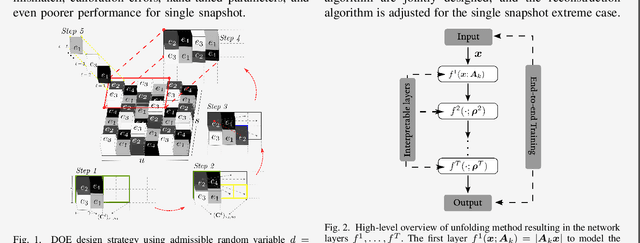



Abstract:Phase retrieval in optical imaging refers to the recovery of a complex signal from phaseless data acquired in the form of its diffraction patterns. These patterns are acquired through a system with a coherent light source that employs a diffractive optical element (DOE) to modulate the scene resulting in coded diffraction patterns at the sensor. Recently, the hybrid approach of model-driven network or deep unfolding has emerged as an effective alternative because it allows for bounding the complexity of phase retrieval algorithms while also retaining their efficacy. Additionally, such hybrid approaches have shown promise in improving the design of DOEs that follow theoretical uniqueness conditions. There are opportunities to exploit novel experimental setups and resolve even more complex DOE phase retrieval applications. This paper presents an overview of algorithms and applications of deep unfolding for bootstrapped - regardless of near, middle, and far zones - phase retrieval.
SSR-PR: Single-shot Super-Resolution Phase Retrieval based two prior calibration tests
Aug 12, 2021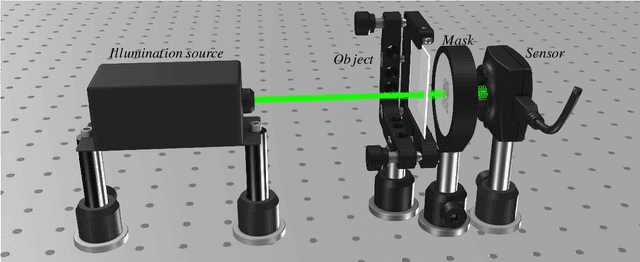

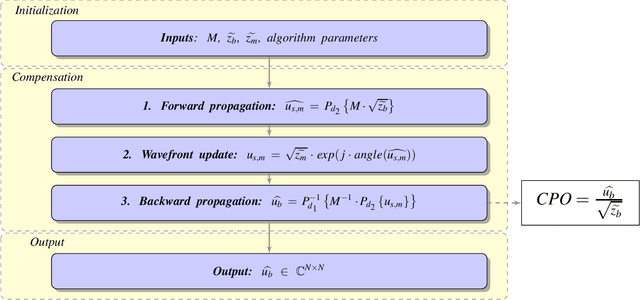
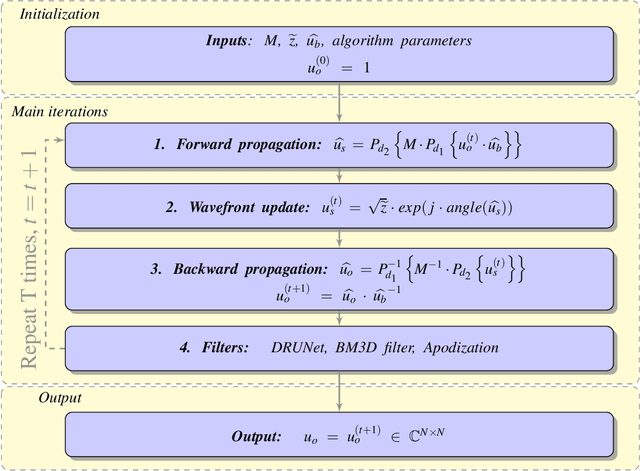
Abstract:We propose a novel approach and algorithm based on two preliminary tests of the optical system elements to enhance the super-resolved complex-valued imaging. The approach is developed for inverse phase imaging in a single-shot lensless optical setup. Imaging is based on wavefront modulation by a single binary phase mask. The preliminary tests compensate errors in the optical system and correct a carrying wavefront, reducing the gap between real-life experiments and computational modeling, which improve imaging significantly both qualitatively and quantitatively. These two tests are performed for observation of the laser beam and phase mask along, and might be considered as a preliminary system calibration. The corrected carrying wavefront is embedded into the proposed iterative Single-shot Super-Resolution Phase Retrieval (SSR-PR) algorithm. Improved initial diffraction pattern upsampling, and a combination of sparse and deep learning based filters achieves the super-resolved reconstructions. Simulations and physical experiments demonstrate the high-quality super-resolution phase imaging. In the simulations, we showed that the SSR-PR algorithm corrects the errors of the proposed optical system and reconstructs phase details 4x smaller than the sensor pixel size. In physical experiment 2um thick lines of USAF phase-target were resolved, which is almost 2x smaller than the sensor pixel size and corresponds to the smallest resolvable group of used test target. For phase bio-imaging, we provide Buccal Epithelial Cells reconstructed in computational super-resolution and the quality was of the same level as a digital holographic system with 40x magnification objective. Furthermore, the single-shot advantage provides the possibility to record dynamic scenes, where the framerate is limited only by the used camera. We provide amplitude-phase video clip of a moving alive single-celled eukaryote.
ADMM and Spectral Proximity Operators in Hyperspectral Broadband Phase Retrieval for Quantitative Phase Imaging
May 14, 2021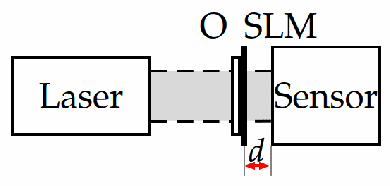


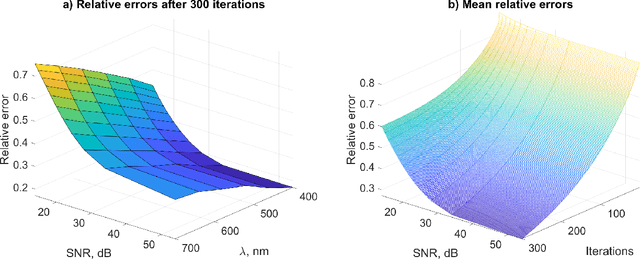
Abstract:A novel formulation of the hyperspectral broadband phase retrieval is developed for the scenario where both object and modulation phase masks are spectrally varying. The proposed algorithm is based on a complex domain version of the alternating direction method of multipliers (ADMM) and Spectral Proximity Operators (SPO) derived for Gaussian and Poissonian observations. Computations for these operators are reduced to the solution of sets of cubic (for Gaussian) and quadratic (for Poissonian) algebraic equations. These proximity operators resolve two problems. Firstly, the complex domain spectral components of signals are extracted from the total intensity observations calculated as sums of the signal spectral intensities. In this way, the spectral analysis of the total intensities is achieved. Secondly, the noisy observations are filtered, compromising noisy intensity observations and their predicted counterparts. The ability to resolve the hyperspectral broadband phase retrieval problem and to find the spectrum varying object are essentially defined by the spectral properties of object and image formation operators. The simulation tests demonstrate that the phase retrieval in this formulation can be successfully resolved.
Optimized Power-Balanced Hybrid Phase-Coded Optics and Inverse Imaging for Achromatic EDoF
Mar 09, 2021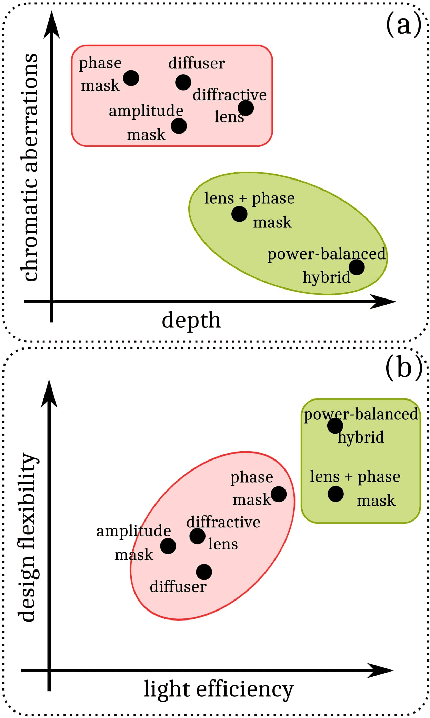


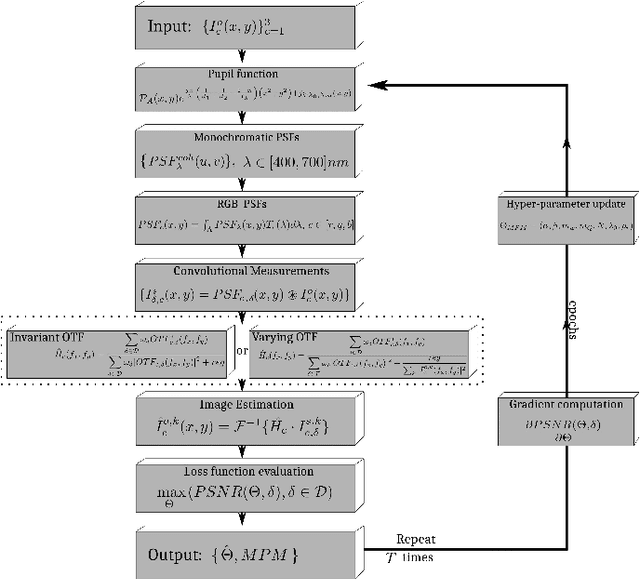
Abstract:The power-balanced hybrid optical imaging system is a special design of a computational camera, introduced in this paper, with image formation by a refractive lens and Multilevel Phase Mask (MPM) as a diffractive optical element (DoE). This system provides a long focal depth and low chromatic aberrations thanks to MPM, and a high energy light concentration due to the refractive lens. This paper additionally introduces the concept of a optimal power balance between lens and MPM for achromatic extended-depth-of-field (EDoF) imaging. To optimize this power-balance as well as to optimize MPM using Neural Network techniques, we build a fully-differentiable image formation model for joint optimization of optical and imaging parameters for the designed computational camera. Additionally, we determine a Wiener-like inverse imaging optimal optical transfer function (OTF) to reconstruct a sharp image from the defocused observation. We numerically and experimentally compare the designed system with its counterparts, lensless and just-lens optical systems, for the visible wavelength interval (400-700) nm and the EDoF range (0.5-1000) m. The attained results demonstrate that the proposed system equipped with the optimal OTF overcomes its lensless and just-lens counterparts (even when they are used with optimized OTFs) in terms of reconstruction quality for off-focus distances.
Hyperspectral holography and spectroscopy: computational features of inverse discrete cosine transform
Oct 04, 2019



Abstract:Broadband hyperspectral digital holography and Fourier transform spectroscopy are important instruments in various science and application fields. In the digital hyperspectral holography and spectroscopy the variable of interest are obtained as inverse discrete cosine transforms of observed diffractive intensity patterns. In these notes, we provide a variety of algorithms for the inverse cosine transform with the proofs of perfect spectrum reconstruction, as well as we discuss and illustrate some nontrivial features of these algorithms.
 Add to Chrome
Add to Chrome Add to Firefox
Add to Firefox Add to Edge
Add to Edge